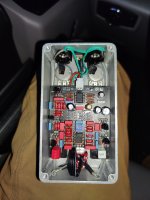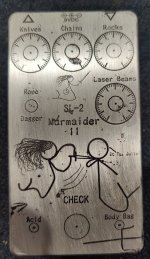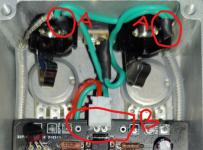Can you go into some further detail on that? I got two fun yet ticky pedals (Sea Horse and Chaos Machine), this seems like a nice fix.
A - what's going on here? how to you split the tip/sleeve signals and send that to the board?
B - where is the sleeve signal going, if not in these spots?
C - bonus, love that you took these pics in your car, on your knee. ingenuity, scrappy and resourceful - qualities I've come to expect from
@Stickman393
View attachment 14143
Happy to! Although with the caveat that I am no electrical engineer; I am but a simple HVAC mechanic. My understanding of some of these concepts might be a little...eh...inelegant.
In essence, I'm creating a faraday cage around my input and output signal wires.
The concept is a little heady, but for our purposes it's a means of preventing electromagnetic "noise" from effecting the electrons in a conductor.
This can be achieved by wrapping a conductor, or set of conductors, in a conductive braid or foil "shield". The shield alone doesn't do much though; by bonding the shield to ground at a single location, it's ability to absorb electromagnetic noise is greatly increased.
As an astonishingly inept metaphor, think of a boat in the ocean. The boat is your signal, the oceanic and atmospheric currents are electromagnetic noise, the shield is the anchor. Without the anchor, the boat gets pushed around all willy nilly, probably into the loch ness monster or something. If the boat drops anchor, but the anchor is, like, pitifully low mass, it will become dislodged and the currents *still* end up pushing the boat around. The boat's anchor ends up ripping through Nessie's home, making Nessie extra pissed off. Nessie munches on the boat whilst muttering something about humans being super inconsiderate.
BUT...if that anchor has sufficient mass, like if we connect the shield to ground, it's like loch Ness monster camouflage...thingie...I dunno, this metaphor has fallen apart.
Classic example: ever find that your cell phone signal goes to shit when you get into an elevator and the doors close? That's because you've walked into a faraday cage.
How bout a dumb example? When folks that are afraid of wifi buy a metal cage to go around their wireless router and then complain that their wifi signal has gone to shit on amazon reviews. Faraday cage.
Like I said...it's a heady concept, but it has multiple real world uses. That perforated screen in a microwave window? Part of a faraday cage. The outer conductor of a coaxial guitar cable? Faraday cage. Tin foil hat? Faraday cage.
Double espresso in a metal shot glass? Faraday café. I mean, I just made that one up, but why not?
HOWEVER, that part about connecting at a single point is important. Because when you create multiple paths to ground, you get ground loops. We really, really, really want to avoid ground loops because it renders our shield ineffective at best, counterproductive at worst. A big ground loop is basically an antenna.
Soooo...that's what I'm doing there. The shield is terminated at the ring, and isolated from the enclosure everywhere else. The inner conductor is terminated at the tip.
Truth told, those extra little connection points on the circuit board are redundant. A good real-world experiment: take your meter, set it to resistance, and measure between the negative input on an unpopulated board and one of those points. You will read close to 0 ohms, because they're common terminals. All three are connected via board traces, and therefore only ONE offboard connection is required. I suspect that the others are provided to help make enclosure wiring make more "sense" in a visual way, especially for people who are new to the hobby. It's a nice touch provided by pedalPCB.
Although...hmm...now that I think of it: It is possible to create a ground loop if the input/output rings are not isolated from the enclosure. In this case, two paths with differing resistance to the flow of electrons present themselves: one through the conductive enclosure, and one through the conductors that connect the ring terminals and the PCB. Huh.
That is true of the way that I have it wired as well...and I haven't really noticed any undue noise in my builds.
Anyways, that's a long preamble to the following: the "A" locations are simply my ground buss. As a daisy chain, it goes 9vdc pin -> output ring -> Input ring -> PCB. The B location is (red) to 9VDC barrel and (green) to input ring. The other two spots...well, they're already connected to my input and output jack via the single Green wire on my JST connector on my board.
And C...well...shucks. I'm just a dude, made from the same stuff as everyone else. You know. Sticks.
*Edited in a futile attempt for clarity*







